#858 Enter the one-man power saw
Chainsaws: A History
by David Lee, in conjunction with Mike Acres
Madeira Park: Harbour Publishing, 2020 (updated 2nd edition; first published 2006)
$34.95 / 9781550179118
Reviewed by Robert Allen
*
 This book captured my interest right from the beginning with its retro cover showing a 1951 IEL Super Pioneer “one-man power chainsaw,” a 1950s style logging truck being unloaded at a log dump by an A-frame, and a boom man standing to the side with a pike pole ready to start moving the logs around the bull pen. The cover image also boasts that the Vancouver-made IEL Super Pioneer “Does the work of 5 men” — and how true that statement is, even though it would take some time for chainsaws to evolve to that stage of efficiency. All of this points to the post-Second World War era when one-man chainsaws took the world by storm.
This book captured my interest right from the beginning with its retro cover showing a 1951 IEL Super Pioneer “one-man power chainsaw,” a 1950s style logging truck being unloaded at a log dump by an A-frame, and a boom man standing to the side with a pike pole ready to start moving the logs around the bull pen. The cover image also boasts that the Vancouver-made IEL Super Pioneer “Does the work of 5 men” — and how true that statement is, even though it would take some time for chainsaws to evolve to that stage of efficiency. All of this points to the post-Second World War era when one-man chainsaws took the world by storm.

Chainsaws and the logging industry were an important part of my upbringing. I was born and raised in the Comox Valley, and while my Dad, Len Allen, wasn’t employed in the logging industry, three of his close friends were — Bob Pidcock, Art (Spit) Quinn, and Tommy Galeazzi — and I remember that Art Quinn had an old two-man chainsaw collecting dust in his garage. It certainly looked scary to a ten-year old kid! One of my uncles, David Guthrie, was a bookkeeper for Comox Logging and another uncle, Jim Greig, worked his way to the top floor of the Crown Zellerbach office in Vancouver. My brother, Greg Allen, even put in a stint as a mechanic’s helper in Comox Logging’s shop. My Dad owned a small Homelite XL 12 chainsaw and I bought one later for myself for work clearing survey lines. Since then I have owned a Husqvarna 35, a Husqvarna 61, and now I own a Stihl MS 260 with a 20-inch bar.
Prior to reading Chainsaws: A History, my saws were just chainsaws used either for work or for cutting firewood. I hadn’t really given any thought to their history or development of chainsaws, but I now have a much greater appreciation of what was really involved to create these machines that truly could do “the work of 5 men.”
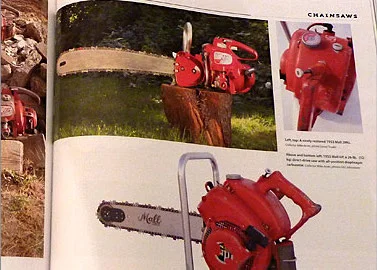
The first saw chain was patented in the USA in 1858; the first in Canada in 1918; but it wasn’t until the early 1950s that the lightweight one-man chainsaw we know today became the norm. In the 1860s the first mechanical saws were steam powered solid-bladed drag saws with a blade similar to a whipsaw, or Swede Saw as they were also known. They were heavy and the accompanying machinery was even heavier and not practical the steep hillsides found in British Columbia and around the world. Charles Wolf founded the first viable commercial chainsaw company in the USA in 1920. Pneumatic and electric-driven, his saws required long electrical cords or pneumatic hoses as well as heavy accompanying machinery.
By the 1920s, European inventors/designers had started producing saws and were taking over the market. By the mid 1920s, Andreas Stihl and his competitor, Emil Lerp, started the chainsaw revolution with the first practical gas-powered saws. Still heavy, they required two people to operate them, one on the motor end and the other at the front with a handle attached to the end of the bar. During and shortly after the Second World War, numerous other companies started building chainsaws and competing for the lucrative market, and soon North American companies were in business with improvements arriving on a near-monthly basis.
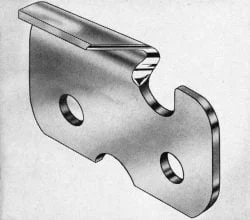
To my mind, the two most important improvements were the design of the chipper chain (the style used today) and the diaphragm carburetor. Who invented the chipper chain, which replaced the old scratch chain, hasn’t been determined, but Joe Cox of Portland started to mass produce them in 1948. By 1950 he had 70 employees making and selling the Oregon brand of saw chains as well as guide bars, sprockets, and other saw accessories and the Oregon chain became the new standard. (I assume that the chains were called Oregon because that is the state in which they were first produced, but I’ve always felt that the cutting tooth also looks a bit like the shape of the State of Oregon — maybe it is the chicken and egg question?!)
In 1950, McCulloch chainsaws were the first to use the diaphragm carburettor, which allowed the saws to be run at any angle and replaced the older gravity-fed system where the carburettor had to be in a vertical position. McCulloch chainsaws continued to come out with other innovation that pushed them to the forefront and set the new standard for saws. McCulloch sold the company to Black & Decker in 1973 and, after a series of owners, the company was closed in 1998 for financial reasons, while Electrolux obtained the rights to use the name outside of the US.

Each chainsaw company tried to come up with a lightweight one-man saw and in 1946 Industrial Engineering Limited (IEL) from Vancouver perfected the first, appropriately named Beaver. Sales took off and they were marketed worldwide.
In 1951, IEL introduced the Super Pioneer model, a force to be reckoned with. It quickly made IEL one of the most successful chainsaw manufacturers in the world. In 1956, Outboard Marine Corporation bought out IEL and moved the operations to their factory in Peterborough, Ontario. They did, however, retain the Pioneer name and the saw sales continued to do well into the late 1970s.
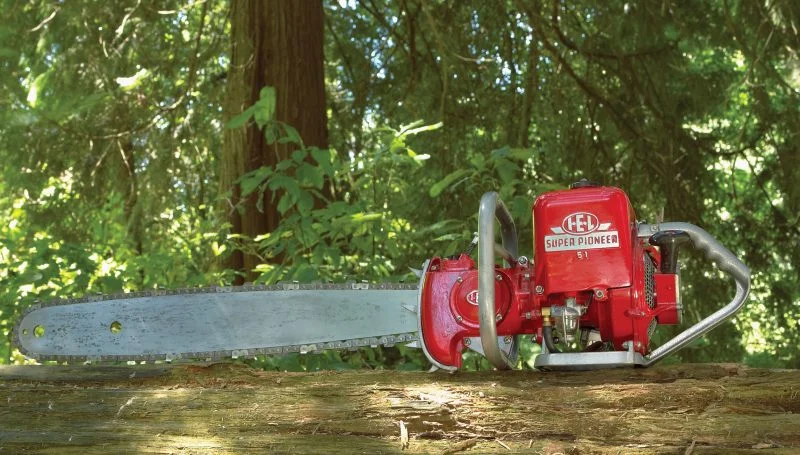

Another Vancouver company, Power Machinery Ltd (PM), got into the chainsaw market in 1947 and by 1950 had sold almost 18,000 saws, more than half of them the Woodboss model. In 1952, PM was making the Rocket, a one-man chainsaw, and by this time had broken into the world market. They also wanted a slice of the lucrative pulp market in central Canada, especially Quebec, so PM owner, Lawrence Killam, had his engineers come up with a saw for that market and named it “Canadien.” The marketing ploy worked and a lot of those saws were sold in Quebec as well as around the world. In 1962, PM was sold to Bristol Aero Industries of England who moved the factory to a large hangar at the Vancouver Airport. They kept the PM name and continued with an expanded Canadien line.
Another Vancouver start-up, and the last significant chainsaw manufacturer in British Columbia, was Quadra Manufacturing Ltd. With some government funding and other incentives, Quadra moved to Trail and set up shop there; by September 1972, they were producing their first Frontier chainsaw, the Mark 1. A lightweight saw popular with arborists and firewood and pulpwood cutters, in only five months they had sold a very respectable 10,000 saws. Frontier had also been making saws for Electrolux, who in turn sold them under their other brand names such as Husqvarna, Jonsered, and Partner; but by 1979 they were having financial problems and Electrolux bought them out and added them to their stable of chainsaw companies.
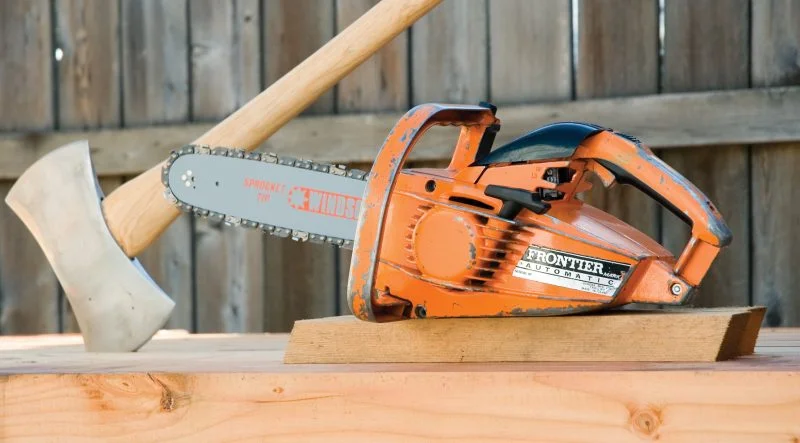
By the mid 1980s numerous other chainsaw companies had been forced out of the market by big manufacturers like Stihl and Electrolux/Husqvarna. However, one last North American saw company that caught my interest was Homelite, probably because I grew up using one and I’ve owned one too. The company started making saws in 1949 and in 1964 they brought out the first Homelite XL-12, which is the model my father had. It was a lightweight saw designed for the homeowner market. It and similar models did very well in sales: by 1971, they had sold three million, and by 1978, they were selling a million saws a year. Even now, they continue to be a major force in the consumer models under 50 cc.
For Chainsaws: A History, David Lee consulted with a number of chainsaw collectors including Mike Acres of Burnaby and Marshall Trover of Renton, WA. Both have extensive chainsaw collections of all types and sizes. Near the back are short biographies of Acres and Trover. Lee also obtained information from the various publications listed at the back of the book, all of which enabled him to write this comprehensive study of virtually every model of chainsaw ever made. In the last chapter, “The Twenty-First Century,” Lee provides a few paragraphs about how the use of gas-powered chainsaws could be contributing to climate change, and that this might now be changing with new lithium-ion battery powered chainsaws. These battery-powered saws will be a force to be reckoned with in the future. Near the end of Chainsaws, Lee provides a useful three-page chainsaw history timeline from 1858 to 1982. The extensive index enables one to find the page that a particular model of chainsaw is listed on.
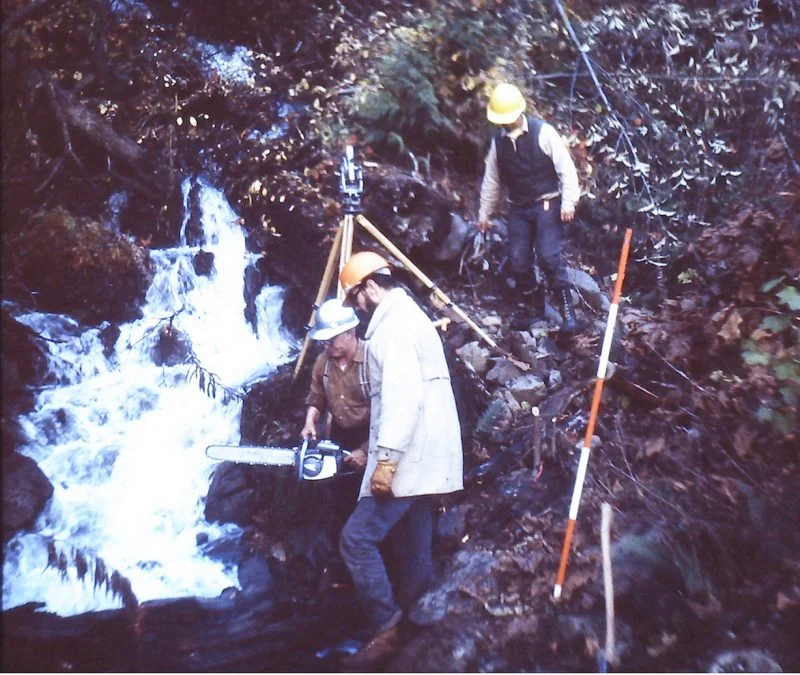
Chainsaws contains hundreds of photographs, mostly in colour, of all types of saws with two, three, or four on each page. Lee’s text is light and easy to read and understand. Chainsaws is an excellent coffee table book, one that can be picked up and read a bit at a time or read all the way through. To me, one paragraph summarizes the main attributes of the miracle of the “one-man power chainsaw:”
The modern gas-powered chainsaw is light-years ahead of its early predecessors, but it’s still noisy, stinky, dangerous, and cantankerous. Maybe that’s part of the machine’s appeal: using a chainsaw demands all the calmness, concentration, and common sense you can muster. Even with those qualities, success is never guaranteed but without them, failure can be catastrophic.
I can recommend Chainsaws: A History as a comprehensive study of all makes and models to anyone who has ever owned or used a chainsaw or is thinking of buying one.
*
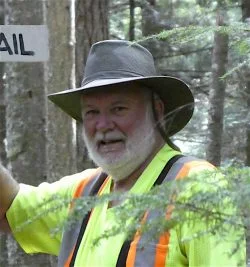
Robert Allen is a Life Member of the Association of British Columbia Land Surveyors (ABCLS), a Life Member of the Canadian Institute of Geomatics, and a Canada Lands Surveyor. A past president of both the ABCLS and the Association of Canada Lands Surveyors, he has also served as the chair of the ABCLS Historical and Biographical Committee for the past 28 years. Raised in Courtenay, he has spent most of his working career in Sechelt. Now retired from active practice, he remains active in Sunshine Coast Search and Rescue (Team Leader and Treasurer), the Sunshine Coast Lions Club (Past President), and the Sunshine Coast Lions’ Housing Society (President). This latter society runs a $20 million, soon to be $40 million, subsidized housing complex in Sechelt for Seniors and others with disabilities.
*
The Ormsby Review. More Books. More Reviews. More Often.
Publisher and Editor: Richard Mackie
The Ormsby Review is a journal service for in-depth coverage of B.C. books and authors. The Advisory Board consists of Jean Barman, Robin Fisher, Cole Harris, Wade Davis, Hugh Johnston, Patricia Roy, David Stouck, and Graeme Wynn. Scholarly Patron: SFU Graduate Liberal Studies. Honorary Patron: Yosef Wosk. Provincial Government Patron since September 2018: Creative BC
“Only connect.” – E.M. Forster
































10 comments on “#858 Enter the one-man power saw”
Hi looking for Chain saws actually made in Canada- Do we make any anymore? Needs- cutting firewood
I have been reading a few articles about the history of chainsaws, most I read I felt that there were “missing links” in the story. This is the only article that covers those missing links, namely the revolutionary 1946 IEL Beaver and the 1950 McCulloch diaphragm development.
Thankyou for writing this article.
I have a pioneer chain saw made in vancouver canada says IEP vancouver canada its all intact looking to sell it its a beauty
Hi Dave, sounds great! But how can people contact you? We shouldn’t really act like a “Buy, Sell, and Trade” service, but if your intentions are good I will post another comment here, with your contact info. Thanks, Richard Mackie, Publisher, BC Review
Hi. How much are you selling it for and where are you located?
If I had the money to purchase one I’d be looking at one of the battery powered saws. They are not quite as powerful (despite the hype!!!) as a 50cc saw but they are mighty close and “good enough” for cutting firewood.
When you are old and retired (not that I know anyone that fits into that category)you don’t want to be lugging around a dinosaur (pun intended) like the 066 or 070. Here in Australia the good quality battery saws eg Makita, Echo, DeWalt that can handle a 16-18 inch bar cost around A$1000.
Fun fact at least for me. My dad’s cousin Ray Pitre owned IEL Pioneer in the 1940s and 50s. He sold out to OMC in 1956. IEL was in Burnaby BC.
Some of the detail in Allen’s account strikes a sour note for me. Story I heard repeatedly in childhood from people who knew Pitre told that he made a goodly fortune from the Privateer Gold mine in Zeballos, which is an interesting story in itself. Then during WW2 someone in BC dismantled a Dolmar chainsaw and realized that there was no mystery in the thing. So, with Germany in disarray, he copied the Dolmar design and starting cranking out the IEL brand from a plant in Burnaby. Sales were good but times were also tough, so employees were paid partially in shares, which were not worth very much. Consequently, some of the more senior people in ‘management’ bought shares on the cheap and held them. When Outboard Marine bought the show in 1956, those shares were a bonanza for those who had held on! Those guys pooled their resources and expertise, and by 1958, they were making the Canadien Chainsaw from a plant near the Vancouver airport under the Power Machinery banner. I still have one of them! Pretty good saw. The Name Dalrymple was somehow implicated in that outfit. Later, when Skill bought PM, the employees struck off on a new venture making a European saw under licence.
My dad and uncle worked for Petre and another cousin of theirs, Herb Ceavis, who was Petres’ partner in the Privateer.
Dolmar was the first. I believe Stihl bought the saw from Dolmar.